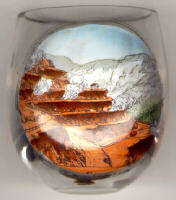

|
| ÖSTERREICH | AUSTRIA |
| Bundesland: Steiermark | Styria |
| Bezirk: Leoben |
 The Erzberg (Ore Mountain) near Eisenerz
is one of the most beloved landmarks of the province of Styria, lovingly called the 'the iron hat of Styria'.
The history of iron mining at this place goes back for more than 16 centuries, as already
the Romans knew of the place as the source of the ferrum noricum (4th century).
The first written document mentioning iron mining dates from 1171. At first
only underground mining was done, but later surface mining [see glass]
became the main source of iron. The latter changed the appearance of the mountain
completely and its height decreased from originally 1,524 m to 1,466 m
today. The Erzberg was the largest iron deposit in the Austrian Empire,
and also was the largest one in Europe that was exploited by surface mining.
For smelting, the iron was originally transported either north to Eisenerz
(Innerberg)
or south over the Präbichl pass to Vordernberg. In modern times
the main industries using the iron were (and still are) situated in Linz
and Leoben/Donawitz.
The Erzberg (Ore Mountain) near Eisenerz
is one of the most beloved landmarks of the province of Styria, lovingly called the 'the iron hat of Styria'.
The history of iron mining at this place goes back for more than 16 centuries, as already
the Romans knew of the place as the source of the ferrum noricum (4th century).
The first written document mentioning iron mining dates from 1171. At first
only underground mining was done, but later surface mining [see glass]
became the main source of iron. The latter changed the appearance of the mountain
completely and its height decreased from originally 1,524 m to 1,466 m
today. The Erzberg was the largest iron deposit in the Austrian Empire,
and also was the largest one in Europe that was exploited by surface mining.
For smelting, the iron was originally transported either north to Eisenerz
(Innerberg)
or south over the Präbichl pass to Vordernberg. In modern times
the main industries using the iron were (and still are) situated in Linz
and Leoben/Donawitz.
An old popular legend explains the origin of the iron: In ancient times three fishermen caught a waterman when they were fishing in a nearby lake, the Leopoldsteiner See. When they took him back to their village the waterman began to struggle as soon as the Erzberg came in sight. To get free, he let them choose between three gifts: They could have either a river of gold that soon would end, a silver heart consumed in time, or an iron hat that would last forever (In another, less-known version the choice is between gold for ten years, silver for one hundred years or iron forever). The fishermen chose the iron and when they set him free, the waterman pointed at the Erzberg, told them that they could find iron there and disappeared in the depths of a nearby karst spring, the Wassermannsloch.
Although the Erzberg is the world's largest deposit of siderite (FeCO3), the mean iron content of only 22–40 % makes iron mining less and less profitable. Underground mining was stopped in 1986 and parts of the adits were converted into a mining museum which is a major tourist attraction of the area.
'Arzberg' is an old version of the German word 'Erzberg' ('ore mountain').
Further glasses of this collection show the municipality Arzberg in eastern Styria,
and Reichraming (Upper Austria), one of the cadastral districts of which is also called Arzberg.
|
![[scale]](lineal.jpg)